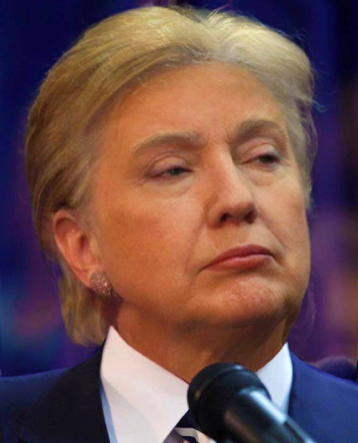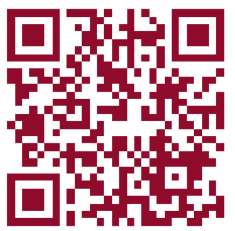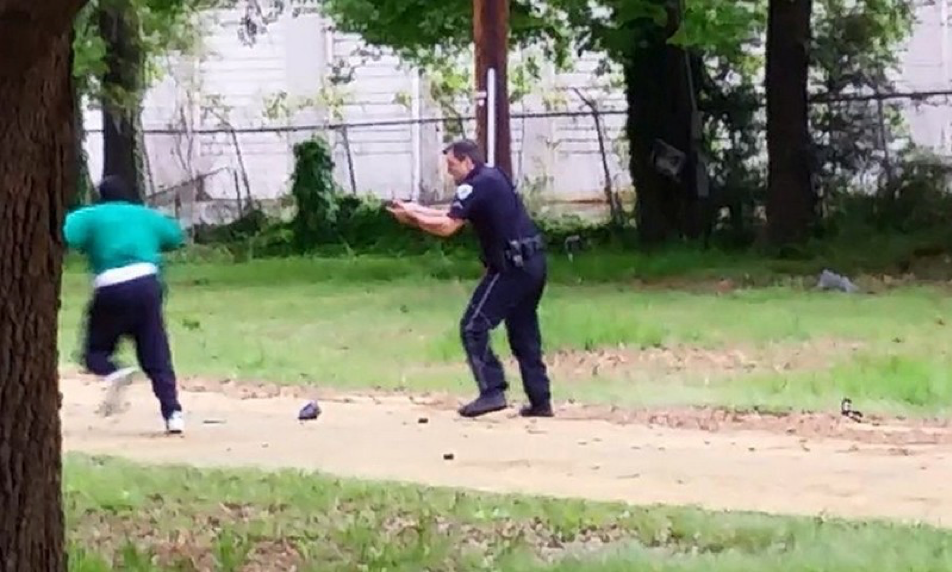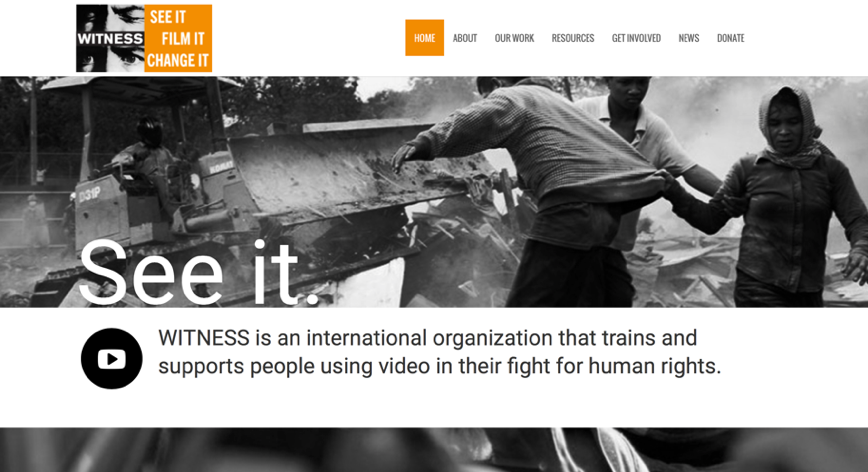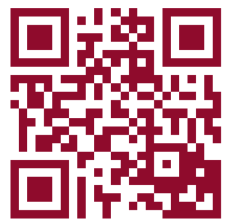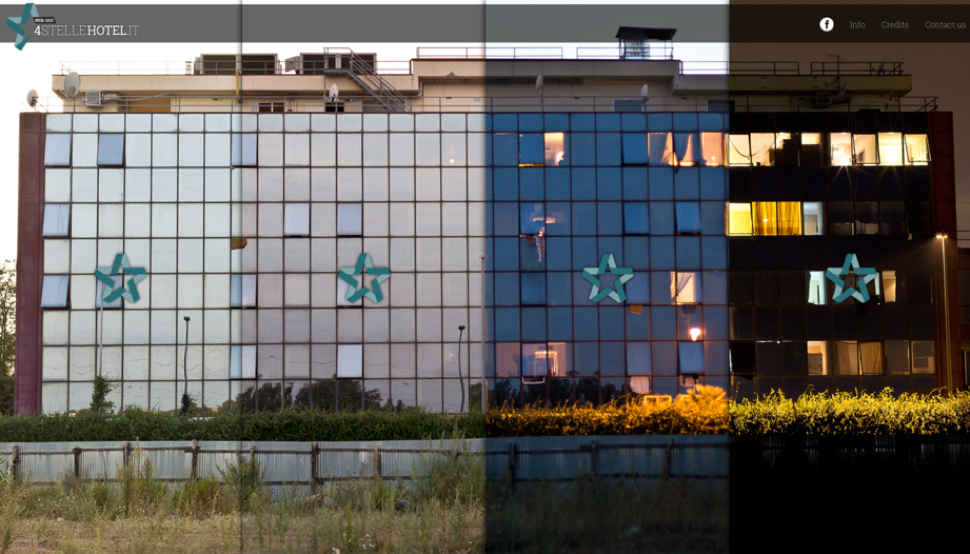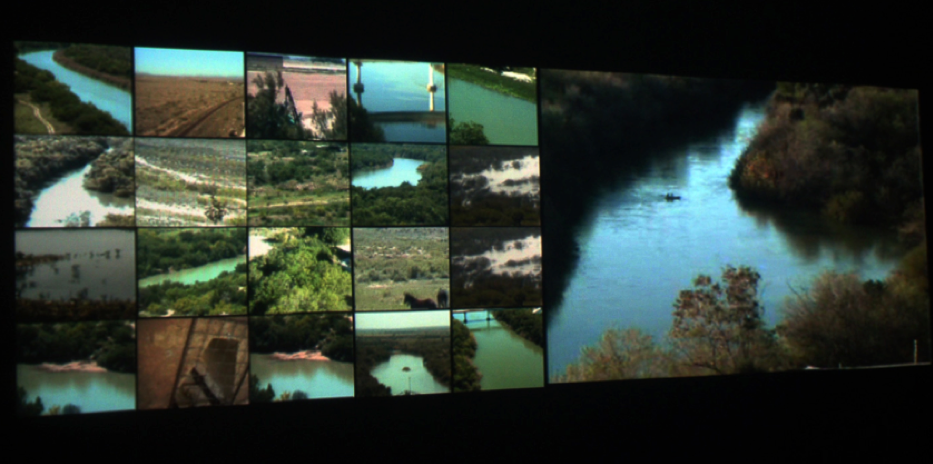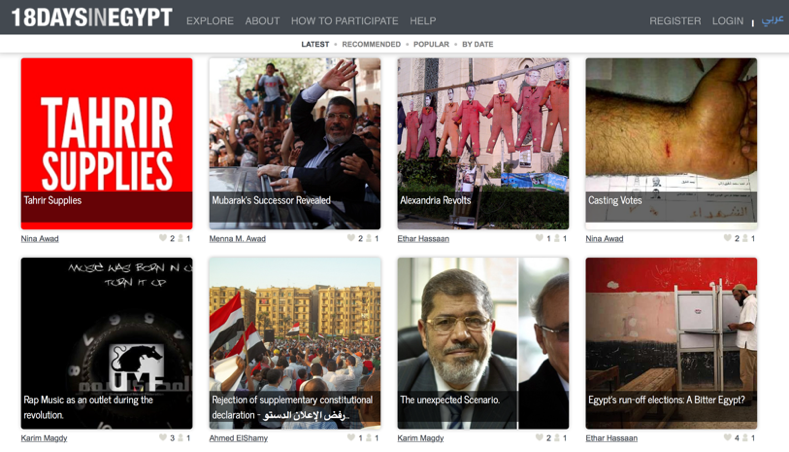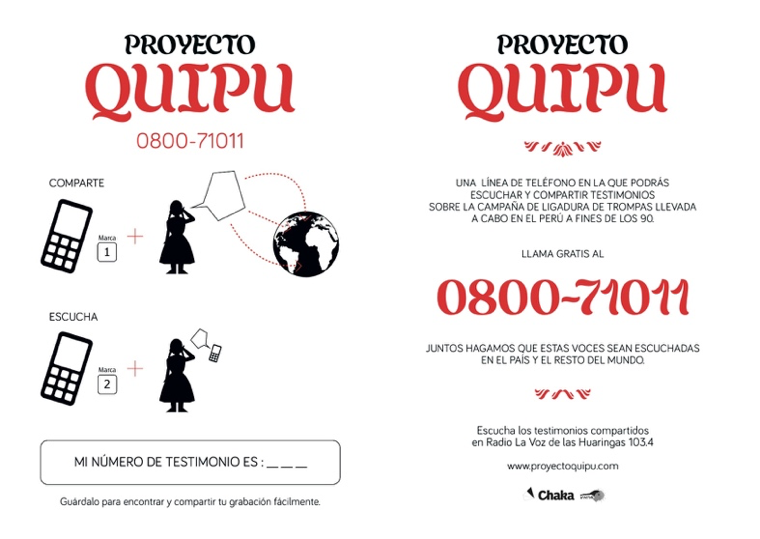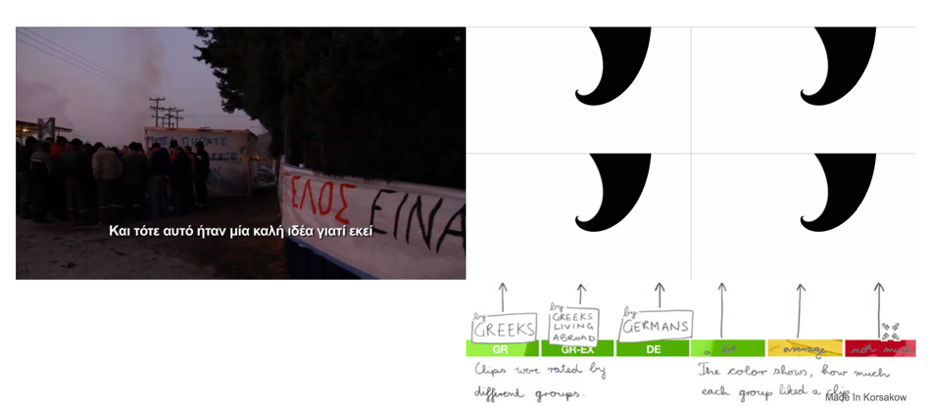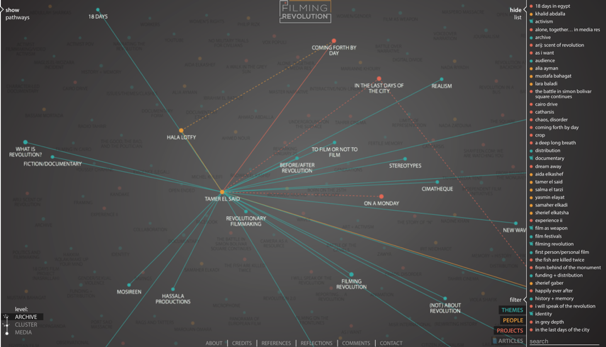Exercising Radical Democracy: The Crisis of Representation and Interactive Documentary as an Agent of Change
Amir Husak
Introduction
Since its early days, documentary has been on the forefront of examining and critiquing society and challenging our knowledge about the world. It has aimed to do this through the stories of real people, daring to address the most pressing and complicated issues, probing various power structures, and frequently positioning itself as an active agent of social change. Documentary is, broadly speaking, principally concerned with the real. It is a vocation for devoted truth seekers, human rights advocates and social justice warriors. Being a documentarian implies poking around archives, spending months or even years living with the protagonists, charting strange new territories, and educating about people and situations that otherwise stay invisible and out of reach. A century of social engagement through documentary shows that the affective powers of documentary can raise awareness, change lives, form and mobilise communities, and influence policy makers. It is no surprise then that a long list of scholars, artists and activists have produced, studied and perceived documentary first and foremost as a democratic tool with civic potential. Bill Nichols famously remarked that documentary belongs to the register of “discourses of sobriety”, seeking to exercise power for particular goals (Representing 32).
The emergent forms of documentary—and the focus here is on the interactive, web-based variants—are not much different. In the last ten years, many projects—GDP (Helene Choquette, 2009), 4 Stelle Hotel (Valerio Palermo and Paolo Muscella, 2014), Le Grand incendie (Samuel Bollendorff and Olivia Colo, 2013), Rapporteur de crise (Bollendorff and Colo, 2011) and 18 Days in Egypt (Yasmin Mehta and Jigar Elayat, 2011), to name but a few—have been conceived as immediate responses to the profound social and economic disruptions of our time. These works can be considered forms of present-day political interventions with a particular social goal in mind. Just like their linear predecessors, they aim to grapple with social issues and intervene in places where misconceptions or abuses of power lead to discord and suffering. But what distinguishes these new forms of cultural expression from their time-based counterparts are particular technological affordances and audience dynamics. Particularly striking is the wide range of possibilities for simultaneous collective and collaborative work across different media and remote geographical locations. With it, the questions of representation, authenticity and voice—issues that have always bedevilled documentary practice—have also grown to become more complex.
Subject to change and anonymous authorship, dispersed, open-ended and vulnerable to manipulation, the emerging digital forms of documentary seem inherently erratic. It is, however, their ability to visualise complexities and incorporate multiple perspectives that perhaps attracts the most. The polyvocality of some of these projects is not only an aesthetic modality, but also a method of production. It can be read as a quest for emancipatory politics, a search for an aesthetic that maybe closely resembles what Frederic Jameson once anticipated and labelled as “cognitive mapping”—the means to show social totality, shed light on class structures, and make our present world comprehensible through a situational apprehension of our own circumstances (347).
Documentary Uncertainties and the Image Apparatus
Commenting on epistemological shifts in documentary early in the 1990s, Bill Nichols foreshadowed the impending crisis and the concomitant structural changes when he wrote:
Traditionally, the word documentary has suggested fullness, and completion, knowledge and fact, explanations of the social world and its motivating mechanisms. More recently, though, documentary has come to suggest incompleteness and uncertainty, recollection and impression, images of personal worlds and their subjective construction. (Blurred 1; emphasis in the original)
Since then, the functions and capacities of documentary practice have greatly expanded and altered our understanding of the form. A new shadow of uncertainty has evolved to accompany contemporary, digital forms of documentary. As evident in many projects of the newer date, the meanings are rarely explicit, complete or clearly defined. Instead, the works are permanently open to reinterpretation and reconstruction. But in contrast to the days when independent documentaries were screened in alternative venues and often only to the communities they portrayed, the new socially engaged documentary heavily relies on communication networks, data centres, corporate infrastructures and platforms such as YouTube, where it exists among many other pieces of media, unstable and ready to be repositioned. Although this particular “problem” relates to and affects so many other systems of knowledge production of the present, one can trace its origins to the early days of digital media.
The beginnings of digital documentary, it should be noted, occur in the nascent days of post-Fordism—an age marked by fragmentation and pluralism, incommensurable heterogeneity, immaterial labour and an upsurge in individualist modes of thinking (Kumar 76). The wide and deep, sweeping changes have left no stone unturned, and have profoundly influenced economy, politics and industrial relations, culture and ideology. Thus, the contemporary documentary crisis is, one could argue, a mere reflection of the widespread epochal changes. The Internet, with its maze of contradictions, further added to such complexity and also deepened the representational crisis. It gave rise to a whole new world of remixes, mashups, low-resolution mobile phone videos, incriminating recordings, snapchats, selfie sticks and drone cameras; slices of reality that terrify, disturb, confuse, but also entertain, motivate, and inform. Are these the twenty-first century versions of what the Lumière brothers once called “actualities”, mere reflections of the world? Be that as it may, much of media conversations such as the debates about the fake news phenomenon—put forward one troubling question: is this for real?
Figure 1: “Trillary”, a Photoshop mashup of Donald Trump and Hillary Clinton that surfaced
on image sharing site Imgur in early 2016. Author unknown.
The disputes over authenticity go astray and frequently turn into conversations about technological developments, i.e. the advent of digital tools and advanced methods for capturing, manipulating, and distributing audiovisual content. But there is much more at stake. The resulting uncertainties prompt much larger questions about the underlying economic and social powers that shape the trajectory of the new crisis.
The Crisis of Representation
The real problem, as Berlin-based artist Hito Steyerl suggests, is that the political representation of the people is diminishing in many ways. This is evident in the current crisis of migration politics and the refugee situation in Europe and the United States—take for example the lack of representation of refugees drowning in the Mediterranean or those who are being held in detention centres and camps. Steyerl asserts: “If people are no longer represented politically, then maybe other forms of symbolic representation are undermined as well. If political representation becomes abstract and blurred, so might documentary representation” (2). When such dynamics take hold, it is perhaps necessary to first destroy the current image apparatus before the new, better representations can be born; something Steyerl and her daughter Esme hinted at in their video performance titled Strike II (2012):
Figure 2: QR code for YouTube upload ofHito Steyerl’svideo performance Strike II (2012).
Building a case for nonlinear storytelling, some filmmakers and theorists argue that plain, linear narratives with a binary code of meaning are not adequate for dealing with the complexities and incoherence of present-day reality. In his film Bitter Lake (2015), Adam Curtis argues that the ruling class now governs with simple storylines of good and evil that are increasingly unconvincing and hollow. Although they are supposed to help us make sense of the world, Curtis notes, such interpretations of lived history are outright flawed and dangerous. In his keynote address at the 2016 i-Docs symposium in Bristol, Korsakow inventor and database filmmaker Florian Thalhofer agreed with Curtis and proceeded to argue that there is a global regime of linear storytelling, instituted by Hollywood (“The Way”). Thalhofer advocated for nonlinear, database filmmaking and polyvocal narratives as one of possible answers to the challenges facing both contemporary documentary and society at large. In the context of these predicaments, it is increasingly important to look at the emergent forms of documentary and understand whether and how they can harness the new powers of affect.
Interactive Documentary: A Capable New Agent of Social Change?
So, what can this new form of documentary offer and do differently, or—in light of problems outlined above—what can it do better? First, there is no denying that the emergent documentary media transcend some of the limitations of time-based, linear forms. In interactive documentary, for example, alternative versions of contemporary reality can be presented in a way that opens up multidimensional engagements with the text. Whereas traditional documentaries build their arguments in time-based sequences, interactive documentaries often rely on spatial arrangements, rhizomatic structures, and various affordances of the digital, networked communication tools. The immediacy and reciprocity of their supporting technologies also radically change the way we approach social engagement today. By operating more in space than time, they allow for a much more complex structure where ideas and plots can freely unfold, pause, retract, run parallel to each other, or be completely taken apart. Most importantly, they harbour the promise of democratic participation. What stands out, again, are the vast possibilities of cocreation, collaboration and widespread distribution. There is a fundamental break with the passive experience of media reception built into these new forms. The product is no longer an object but a shared project with the public, or the so-called users (Bishop 37). Audiences are no longer passive consumers of content; they are role players.
Scholars Helen De Michiel and Patricia Zimmerman have labelled some of these works open space documentaries, “zones where reclaiming media technologies happens in order to re-envision interactive public, democratic and social relationships” (11). De Michiel posits:
For now, these zones blur distinctions between nonfiction and fiction, professional and amateur, audience and creator, powerful and subjected. They are distinctly permeable places where culture and social change meet in dialogue and synthesize new ways of thinking, imagining, and behaving (2).
Documentary media makers and activists have been tapping into this new realm of possibilities. Several recent interactive documentary works have demonstrated unprecedented forms of interaction and participation, some of which easily transcend national borders or even break out of the confines of their own institutional and political frameworks. The following paragraphs highlight some of the tools and methods and examine several projects that catalyse surprising new forms of social relationality. Note that the selection of works here is somewhat accidental as it mostly includes projects I have personally studied, followed and reflected upon over a longer period of time. There are certainly a lot more examples out there.
Mobile Video and the New Activist Citizen
The two things that truly expanded the dialogic, participatory and social dimensions of digital documentary are the rise of mobile video and the social media as a parallel public sphere with its imagined communities. [1] These two developments have brought rarely heard voices into public focus and enabled greater influence and correspondence between protests staged virtually and those happening in physical reality. It is important to note here that the labour of capturing visual evidence is no longer delegated solely to the professional filmmakers and media activists. Anyone with a mobile phone can record and participate/intervene. Commenting on such citizen-activist uses of mobile, Michael Chanan writes:
Within the manifold of digital communicative practices, video has come to play an exemplary role in purveying alternative versions of contemporary reality that belie official discourse... typically shot on the streets with a mobile phone in the heat of the moment and rapidly posted on YouTube, (it is) providing vital evidence of events beyond the reach of the centralized mainstream media. (219)
This is perfectly demonstrated in mobile documentations of the recent plight of refugees in Europe and the struggles again racism and police brutality in the United States, where ordinary citizens recorded and share countless evidence of power abuse and thereby influenced public discourse. One such video, for example, led the grand jury in South Carolina to sentence Michael Slager, a white police officer, to twenty years in federal prison for the murder of Walter Scott, a black citizen, in April of 2015. The video that surfaced on the web clearly contradicted the official police report and shows the policeman shooting the unarmed Scott from behind, and then planting what looks like a taser gun next to his body.
Figure 3: Citizen-recorded mobile video as critical evidence: shooting of Walter Scott, April 2015. Screenshot.
The videos of the killings of Walter Scott, Tamir Rice and Eric Garner have been prominently featured in activist social media campaigns which helped forge an international activist movement, Black Lives Matter, a decentralised network that uses variety of tactics to build power through protest. One of the noteworthy and successful actions included forcing the former president of University of Missouri, Tim Wolfe, to step down after he repeatedly failed to address a series of racist incidents at the university. Although the full impact of the movement’s (digital) strategies may be difficult to assess at this point, BLM has done a remarkable job of employing mobile video as evidence to bring important issues of racial discrimination and structural injustice into the centre of public discourse.
Meanwhile, a whole range of tactics, protocols and guidelines for the use of mobile video as critical evidence are being developed and employed in human rights and social justice campaigns. Arguably the most prominent is the work of WITNESS, an organisation dedicated to training activists and citizen witnesses around the world to capture video with enhanced evidentiary and documentation value. A number of documentary media makers are integrating these practices and developing collaborative, community-oriented works that aim to counterbalance the mainstream narratives.
Figure 4: WITNESS is an organisation that emphasises the importance of video as evidence
in the fight for human rights. Witness.org, screenshot.
Counternarratives and Community-Based Documentary Media
In regard to interface design and content delivery methods, one important difference to traditional film form is that, as Gene Youngblood has put it, “past, present and future can now be spoken in the same frame at once” (27). The possibility of having parallel event-streams allows the viewer to compare and contrast narratives and draw specific conclusions—a polyphony over both space and time par excellence. This has been explored, in various permutations, in a number of projects.
In Samuel Bollendorff and Olivia Colo’s Le Grand incendie, a web documentary about the disturbing rise of self-immolation cases in France, the authors used a simple but very effective technique to combine the two narratives, the official account and an alternate version involving victims and survivors. They are represented on the screen by two waveform lines, much like those on a cardiogram, one on top of the other. The interface itself is an expanded dialectical composite that, in contrast to time-based media and temporal relations between individual shots, employs spatial arrangements and “proleptic montage”. [2]
Figure 5: QR code for video trailer of Le Grand incendie (Samuel Bollendorff and Olivia Colo, 2013).
To apply the taxonomy suggested by Sandra Gaudenzi, the project is semi-closed as it only allows us to browse the embedded media. [3] It painstakingly stitches the events together and suggests that these horrifying deaths are the direct consequence of the tremendous pressures at the workplace and the increased economic insecurity of workers who became victims of corporate consolidations and austerity measures. At the same time, the project employs investigative journalism to sharply criticise media representations and their obvious disregard for the suffering of people involved. It is both categorical and conversational, and operates as a profound challenge to the mainstream version of the events.The web documentary 4 Stelle Hotel tells a story of a self-organised community of some two hundred migrant families who, in search for a shelter, occupy an abandoned luxury hotel on the outskirts of Rome. Unlike Le Grande incendie, this project avoids official interpretations of the situation at the hotel. Instead, it opts for a method that combines visual ethnography and social activism to bring the audience closer to the afflicted. A cluster of voices, varied and autonomous, map out the realities of present-day migration. User experience here is one of approximation, of “being there” and getting to know the inhabitants of an occupied hotel. Site visitors can virtually roam around the hotel and learn about the people who are part of this unique social experiment.
Figure 6: Navigation via four different panels, each representing one part of the day—morning,
afternoon, evening, night—in 4 Stelle Hotel (Valerio Muscella and Paolo Palermo, 2014). Screenshot.
In a Skype conversation, the authors Valerio Muscella and Paolo Palermo told me that they opted for a polyvocal web-based project—their first—because they wanted to make the story accessible to a wider public and quickly contest news reports about the hotel being a hotbed of terrorist activity, prostitution, and crime.
In The Texas Border(Joana Moll and Héliodoro Santos, 2010), the authors/instigators tapped into video recordings from the web-based platform BlueServo, used by the Texas Border Sheriff’s Coalition to surveil parts of the border between the US and Mexico. The Coalition invited the public to anonymously participate by monitoring the live video feeds and report any attempts of illegal border crossings. To paraphrase Nicolas Mirzoeff, in such particular relation between what is visible and what is kept out of sight, the authorities purposefully shaped the world view of the so-called user/participant (19). Using media and data generated by the surveillance website—including the commands which the algorithm spewed out to its obeying citizen agents—the project brought together a mixture of human and machine voices to raise questions about civic responsibility and expose the Orwellian role the police apparatus plays in such interactions. Not to mention thousands of hours of unpaid labour that citizens offered to uphold what Jacques Rancière would describe as “the police version of history” (32).
Figure 7: Orwellian scenarios played out on the webin The Texas Border (Joana Moll and Héliodoro Santos, 2010). Screenshot.
Archives of the People, by the People, for the People
Using a semi-open mode of interaction, Jigar Mehta and Yasmin Elayat’s frequently cited 18 Days in Egypt crowd-sources visual records of the 2011 Egypt uprising. It features a rich tapestry of media that documents the event from the “bottom up”, enabling alternate and arguably more accurate readings of history. The result is an open, accessible-to-the-public digital archive, driven by a database populated with genuine first-hand records of the uprising. The political overtones and potentials of this work are truly momentous. They hint at the possibility of people being in control of their own history, of having a say in the way its narrative evolves and shapes the country’s affairs. Considering the later developments and the current state of affairs in Egypt, the project became an archive of a failed revolution. Yet its power as a unique, unprecedented record of an uprising as told by its protagonists is undeniable. It is both a resource for future engagements and a cautionary tale.
Figure 8 (above): Polyvocal database as an alternate reading of history in 18 Days in Egypt (Jigar Mehta and Yasmin Elayat, 2011). Screenshot. Figure 9 (below): An instructional brochure that was distributed to the indigenous community in the Quipu Project (2014). Screenshot from the project brochure.
Another interesting example of an archive-driven, participatory web documentary work is the Quipu Project (Maria Court and Rosemarie Lerner, 2015).It is a platform and a forum for the indigenous men and women of Peru who were subjected to forced sterilisation during the president Alberto Fujimori’s rule in the 1990s. A great example of a technologically agnostic—by any media necessary (Jenkins et al.)—type of a project, it combines analogue and digital communication tools and methods in a very effective way. As there is no data service in the remote areas where most of the victims live, the creators went into the community and distributed basic mobile phone kits so people could record, listen and share the testimonies via ordinary cell-phone networks. The audio recordings were also made accessible to everyone on the web. Apart from building a remarkable oral history archive, the project aims to mobilise its audiences in a demand for justice. Most importantly, the afflicted are not just the principal subjects of the project, but also its active cocreators. In fact, the project is contingent upon their participation as well as audience interaction to bring this issue into public discourse. Interestingly, the impact of a project like this may also be easier to evaluate, as any subsequent initiatives and legal proceedings could be monitored and possibly linked to the project’s outreach strategies.
Interactive Documentary as an Experiment in Democracy
Florian Thalhofer’s Money and the Greeks(2013), on the other hand, attempts to integrate the underlying principles of democracy into the production process itself. It does so by involving the audience in editorial decisions both on site and online, where they rate the material and decide what stays, what goes, and what deserves further development. Using video vignettes in a nonlinear navigation interface, and interrogating various aspects of the economic crisis in Greece, the project solicited input from three groups of participants: Greeks, Germans, and the Greeks living abroad. The resulting video tapestry is a consensus of sorts, but each clip is colour-coded to indicate how the three participating groups responded to its content (like/dislike/neutral). An experiment in collective decision making, the project allows for varied interpretations of its content. It also questions the very concept of democratic consensus, its meaning and merit in times of crisis.
Figure 10: Interface as an experiment in democratic decision making in Money and the Greeks
(Florian Thalhofer, 2013). Screenshot.
Analysing, Categorising, Naming
Several scholars have done important work classifying and understanding the way these new works communicate with their audience, with distinctions being mainly based on project’s interactive logic. Sandra Gaudenzi, for example, proposed four interactive modes: the conversational, the hypertext, the experiential, and the participative. They primarily relate to the way the user interacts with the text and develops a method of knowledge gathering. Offering a similar analysis of interactivity and the social functions of web-based documentaries Kate Nash suggests that the three well established social functions of documentary—recording and preserving, promoting civic involvement, and persuasion—play a big role in design and development of interactive/web documentary works. Drawing on existing documentary theory, she proposes three categories based on the structural patterns of a web doc: narrative, categorical, and collaborative. Both Gaudenzi’s and Nash’s proposed categorisations provide excellent prisms through which one can analyse a great number of interactive documentary projects. Further expanding on these frameworks—especially in relation to community-oriented interactive documentaries—contemplations and writings on socially engaged art, especially the discourse revolving around the so-called “relational aesthetics” (Bourriaud), can be particularly useful.
Relational Aesthetics
The polyphonic modalities of interactive documentary are greatly reminiscent of earlier, socially engaged art practices. Several scholars have highlighted this link, recognising that both practices are contingent upon public interactions and participation (Aston; Rose; Zimmermann and De Michiel). Active spectatorship is, of course, nothing new in the art world. The Situationist interventions of the 1960s, Fluxus performances, or the recent works by Thomas Hirschorn and Santiago Sierra are just some of the examples that directly involve the public. Art critic Nicholas Bourriaud labelled these tendencies “relational aesthetics”, adding that relational art aims to establish intersubjective encounters in which meaning is elaborated collectively (18). Some of these artworks frame the situation along the lines of what Claire Bishop in her critique of Bourriaud’s concept of relational aesthetics described as “relational antagonisms”. She writes: “This relational antagonism would be predicated not on social harmony, but on exposing that which is repressed in sustaining the semblance of this harmony” (Bishop 79). Upon further inspection of methods of engagement, the link between these practices is evident; they both seek to directly involve the audience and stage virtual, as well as real life encounters, in an effort to achieve perceivable, concrete social change.
Figure 11: Rhizomatic distribution and navigation in Filming Revolution (2015), a meta-documentary
by Alisa Lebow. Screenshot.
The rhizomatic-polyphonic structures are often reflected in the design of these works. They help make sense of increasingly complex power relations and visualise links between various records, people and situations. Their authors/instigators, often working with budgets much smaller than those for feature-length linear documentaries, have purposefully recorded and archived material outside of the framework of mainstream narratives, and coauthored the works to provide genuine evidence of the powers at play, the struggles, and the injustice.
Conclusion
Most of the projects featured in this article are clearly linked to traditional documentary practices, as they exhibit nearly all of Michael Renov’s four fundamental tendencies of documentary: “1) to record, reveal, or preserve; 2) to persuade and to promote; 3) to analyse and interrogate; and 4) to express” (30). But they also go beyond and expand those tendencies. By employing mixed methods—freely combining media formats, designing encounters and encouraging open discussion—interactive documentary does have a potential to develop as one of the battlegrounds where neoliberal capitalism is confronted. It would, however, be ill-advised to equate this new documentary space with the Habermasian public sphere, often seen as a terrain where one should aim for reaching rational consensus. Calling into question official versions of reality requires a more antagonistic approach. In fact, such symbolic enacting of radical democracy through polyvocal creative media practice is exactly what some political theorists have advocated. Chantal Mouffe, for example, argues that the realm of culture plays an important role in challenging hegemonic politics and that it allows for different, new and important forms of identification. Arguing for plural democracy and competing narratives of our identities as citizens, in 1994 she wrote:
A healthy democratic process calls for a vibrant clash of political positions and an open conflict of interests. If such is missing, it can too easily be replaced by a confrontation between non-negotiable moral values and essentialist identities (6).
In the act of resistance, various new forms of citizen engagements through documentary media can play an increasingly important role. Even though it is alluring to think that the emergent media can escape the dictates of mainstream and commerce-driven information, the obstacles faced are not easily surmountable and appear to be similar to those of previous decades. A cautionary tale can perhaps be found in the history of video guerrilla movements of the early 1970s. [4] Just like contemporary digital formats, portable video raised hopes of a more democratic, accessible media production and distribution. The information was to be liberated from the grip of institutional, commercial and reactionary networks. In the hands of activists and critically minded citizens, video was to become a weapon in a fight for a more just, democratic society in which information power remains with the people. Sadly, the consolidation of media markets, the weakening of public TV, cuts in funding, and a number of legislative changes have practically destroyed the power of socially conscious video collectives. There is, however, much to learn from their aspirations, victories, and the subsequent failures.
Interactive documentary, with its polyphonic modalities, could help foster a shared political identity amid many varied struggles for inclusion and power sharing. A healthy dose of utopian thinking and awareness of the paradoxes of new technologies is needed to achieve that. Furthermore, learning from the experiences of the Occupy movement, Alex Juhazs correctly argues that it is important for the activist digital documentary interventions to not remain confined to the representational, virtual realm, but strive for real life encounters, bodily engagements, a spillover into streets and lives. Advocating for polyvocality and what Mouffe has named a “vibrant clash of political positions” is of great importance for these new forms of documentary expression. The key to opening their affective powers, again, is a better understanding and awareness of the underlying economic and social powers that shape the new media landscape.
Notes
[1] Benedict Anderson describes these as communities where solidarity is “created through shared interests and forged through identification rather than face-to-face communication in everyday life” (6–7).[2] In a keynote address at Critical Themes in Media Studies conference in 2007, Alexander Galloway described proleptic montage as an emerging, ubiquitous form of cognitive linking between different elements-windows on a screen, as seen in gaming interfaces, smartphone operating systems, etc.
[3] Gaudenzi proposes classification based on the mode of interaction. She writes: “Whether interactivity is semi-closed (when the user can browse but not change the content), semi-open (when the user can participate but not change the structure of the interactive documentary) or completely open (when the user and the interactive documentary constantly change and adapt to each other) will determine what type of interactive documentary they are” (70).
[4] For a fascinating and thoroughly researched story about the history, rise and fall of guerilla video movements see Boyle.
References
1. Anderson, Benedict. Imagined Communities: Reflections on the Origin and Spread of Nationalism. Revised and extended ed., Verso, 1991.
2. Aston, Judith. “Interactive Documentary and Live Performance: From Embodied to Emplaced Interaction.”Aston, Gaudenzi, and Rose, pp. 222–36.
3. Aston, Judith, Sandra Gaudenzi, and Mandy Rose, editors. I-Docs: The Evolving Practices of Interactive Documentary. Columbia UP, 2017.
4. Barnouw, Erik. Documentary: A History of the Non-Fiction Film. Oxford UP, 1993.
5. Bishop, Claire. “Antagonism and Relational Aesthetics.” October, no. 110, 2004, pp. 51–79.
6. ---. Artificial Hells: Participatory Art and the Politics of Spectatorship. Verso, 2012.
7. Bollendorff, Samuel, and Olivia Colo. Le Grand incendie. Arnaud Dressen & Honkytonk Films, 2013,le-grand-incendie.nouvelles-ecritures.francetv.fr/. Accessed 2 Mar. 2018.
8. ---. Rapporteur de crise. France Télévisions Education & Honkytonk Films, 2011, www.samuel-bollendorff.com/fr/rapporteur-de-crise. Accessed 18 Aug. 2018.
9. Bourriaud, Nicholas. Relational Aesthetics. Translated by Simon Pleasance and Fronza Woods, Les Presses du réel, 1998.
10. Boyle, Deirdre. Subject to Change: Guerrilla Television Revisited. Oxford UP, 1997.
11. Chanan, Michael. “Video, Activism and the Art of Small Media.” Transnational Cinemas, vol. 2, no. 2, 2012, pp. 217–26.
12. Choquette, Helene. GDP. NFB/ONF Canada, 2009, gdp.nfb.ca. Accessed 20 Mar. 2018.
13. Court, Maria, and Rosemarie Lerner. Quipu Project. 2015, interactive.quipu-project.com/#/en/quipu/intro. Accessed 2 Apr. 2018.
14. Curtis, Adam, director. Bitter Lake. BBC, 2015.
15. De Michiel, Helen. “Open Space Documentary.” Animating Democracy/Americans for the Arts,2011, animatingdemocracy.org/sites/default/files/documents/reading_room/HDeMichiel_ TrendPaper.pdf. Accessed 24 May 2016.
16. Elayat, Yasmin, and Jigar Mehta. 18 Days in Egypt. 2011, www.18daysinegypt.com. Accessed 2 May 2018.
17. Galloway, Alexander. “Nonmedia.” Keynote Address, Critical Themes in Media Studies, 7th Annual Conference, New School University, New York, 21 Apr. 2007.
18. Galloway, Dayna, Kenneth B. McAlpine, and Paul Harris. “From Michael Moore to JFK Reloaded: Towards a Working Model of Interactive Documentary.” Journal of Media Practice, vol. 8, no. 3, 2007, pp. 325–39.
19. Gaudenzi, Sandra. The Living Documentary: From Representing Reality to Co-creating Reality in Digital Interactive Documentary. Dissertation, Goldsmiths, U of London, 2013. research.gold.ac.uk/7997/. Accessed 8 Apr. 2018.
20. Jameson, Frederic. “Cognitive Mapping.” Marxism and the Interpretation of Culture, edited by Cary Nelson and Lawrence Grossberg, U of Illinois P, 1988, pp. 347–57.
21. Jenkins, Henry, et al. By Any Media Necessary: The New Youth Activism. NYU Press, 2016.
22. Juhasz, Alexandra. “Ceding the Activist Documentary.” New Documentary Ecologies: Emerging Platforms, Practices and Discourses, edited by Kate Nash, Craig Hight, and Catherine Summerhayes, Palgrave Macmillian, 2014, pp. 33–49.
23. Kumar,Krishan. From Post-Industrial to Post-Modern Society: New Theories of the Contemporary World. Blackwell Publishing, 1995.
24. Lebow, Alisa. Filming Revolution. 2016. www.filmingrevolution.org. Accessed 16 Apr. 2018.
25. Mirzoeff, Nicholas. How to See the World. Penguin, 2015.
26. Moll, Joana, and Héliodoro Santos Sanchez. The Texas Border. 2010, www.janavirgin.com/ texas.html. Accessed 2 May 2018.
27. Mouffe, Chantal. The Return of the Political. Verso, 1993.
28. Muscella, Valerio, and Paolo Palermo. 4 Stelle Hotel. Fabio Ragazzo, 2014, www.4stellehotel.it. Accessed 2 May 2018.
29. Nash, Kate. “What is Interactivity for? The Social Dimension of Web-Documentary Participation.” Continuum: Journal of Media & Cultural Studies, vol. 28, no. 3, 2014, pp. 383–95.
30. ---. “Modes of Interactivity: Analysing the Webdoc.” Media, Culture & Society, vol. 34, no. 2, 2012, pp. 195–210.
31. Nichols, Bill. Representing Reality: Issues and Concepts in Documentary. Indiana UP, 1999.
32. ---. Blurred Boundaries: Questions of Meaning in Contemporary Culture. Indiana UP, 1994.
33. Rancière, Jacques. Disagreement. U of Minnesota P, 1999.
34. Renov, Michael. “Toward a Poetics of Documentary.” Theorizing Documentary, edited by Michael Renov, Routledge, 1993, pp. 12–36.
35. Rose, Mandy. “Not Media About but Media With: Co-creation for Activism.” Aston, Gaudenzi, and Rose, pp. 49–65.
36. Steyerl, Hito. “Documentary Uncertainty.” A Prior, no. 15, 2007, pp. 2–3.
37. ---, performer. Strike II. 2012, www.youtube.com/watch?v=m1tA6eOgRt4. Accessed 10 May 2018.
38. Thalhofer, Florian. Money and the Greeks. Korsakow Institute, 2013, geld.gr. Accessed 2 May 2018.
39. ---. “The Way We Tell Stories.” Keynote presentation. i-Docs Symposium, Bristol, UK, 2 Mar. 2016. www.youtube.com/watch?v=KEnBYi2HY5c.
40. Youngblood, Gene. “Cinema and the Code.” Leonardo,Supplemental Issue, vol. 2, 1989, pp. 27–30.
41. Zimmermann, Patricia R., and Helen De Michiel. Open Space New Media Documentary: A Toolkit for Theory and Practice. Routledge, 2017.
Suggested Citation
Husak, A. (2018) ‘Exercising radical democracy: the crisis of representation and interactive documentary as an agent of change’, Alphaville: Journal of Film and Screen Media, 15, pp. 16-32. https://doi.org/10.33178/alpha.15.02.
Amir Husak is a multimedia artist and faculty in the Media Studies programme at The New School in New York. Exploring documentary as social practice and investigating digital media representation of history and identity politics, he is currently pursuing a practice-based PhD in Leeds, UK. Husak’s works have been shown at such diverse places as South by Southwest (US), Sundance Film Festival (US), Sarajevo Film Festival (Bosnia & Herzegovina), Stadtmuseum Graz (Austria), P.O.V./PBS (US), and TV Cultura (Brazil). He is a recipient of both Fulbright and Jack Kent Cooke fellowships.





